
Editor’s note: This post is one of a series by Eric Whetzel about the design and construction of his house in Palatine, Illinois, a suburb of Chicago. A list of Eric’s previous posts appears below. For more details, see Eric’s blog, Kimchi & Kraut.
When my wife’s cousin found out we were trying to build a high-performance new home (a mix of Passive House and Pretty Good House), he suggested we incorporate his company’s self-tinting glass. Used largely in commercial applications since its introduction, the product (Suntuitive) is beginning to make inroads into the residential market as the cost comes down.
For anyone near the northwest suburbs of Chicago, you can see the glass in person at the Ziegler Maserati dealership in Schaumburg, Illinois.
As the product has continued to evolve, they’ve been able to remove much of the green tint of the glass. This is evident in the Ziegler dealership glass, but even in that application I didn’t think that it was all that prominent. The overall look of the glass was still impressive.
As to function, the Suntuitive coating between the layers of glass adjusts its level of tint based on the temperature of an inner layer. In the summer, this has obvious benefits when high outdoor temperatures combine with glaring sun to heat up a structure, particularly in the east in the morning and the west in the afternoon (even to the south without some protection with overhangs). But the really nice thing about the product is that it doesn’t tint on the coldest days in winter, allowing for some solar heat gain and natural daylight exactly when you want it most on sunny, wintry days.
For energy reasons, and also personal aesthetic choices, we decided to forego any windows on the east side of our house. Instead, we just have our front door facing the street (it has a limited amount of privacy glass to let in some morning light). On the other hand, because we wanted to use a significant amount of glass on the west side, which faces our backyard, and we knew overhangs couldn’t offer much relief from the summer afternoon sun, Suntuitive was a great solution for us — especially since we wanted to avoid using blinds or curtains as much as possible.
Following Passive House principles for glazing, we wanted to optimize our views and connection to the outside through our limited and strategically placed number of windows.
Here’s a useful video showing the effects the sun can have on a structure in various seasons.
And here’s an interesting video discussing the challenges associated with managing both solar orientation and scenic views when they’re in conflict:
We have only a single window to the north (for my daughter’s bedroom). The majority of our windows are on the south side, where we spend most of our time in the living spaces (open kitchen and family room). In effect, we’ve limited our windows in private areas of the house, mainly two bathrooms. Besides energy concerns, we didn’t think it made sense to add additional glass to our north, mainly because our neighbor’s house blocks any meaningful views while also reducing privacy.
Additionally, we have a significant overhang on the south side, which allows us to block out most of the summer sun while allowing in plenty of winter sun for passive solar heating during our coldest months, so the windows on the southern facade easily take care of most of our daylighting needs.
By utilizing the Suntuitive glass on only the west-facing windows (family room and master bedroom) it allows us to maintain our open view of the backyard while avoiding migraine-inducing summer afternoon sun.
Here are the specs for the particular glass we chose to use. (They have a wide variety of options, including color variations.)
Although we lose some potential solar heat gain through these windows in winter (compared to glass in a typical Passive House certified window), we feel that blocking hot, bright summer afternoon sun more than compensates for the loss.
Here’s a company video describing the Suntuitive product in real world applications:
Choosing a window manufacturer
My wife’s cousin suggested a couple of options for the Suntuitive glass: Kolbe Windows and Unilux Windows.
We went to see the Kolbe windows in a local showroom, but they didn’t seem impressive. It also didn’t help that the salesperson was dismissive of the product, suggesting that if we were considering Kolbe we should just use Marvin instead (another brand the store sold). The salesperson literally had to wander around looking for a sample unit, eventually finding one buried in a corner. We’re not even sure if what we saw represented the full breadth of the Kolbe product line.
At any rate, since Unilux was willing to work with the Suntuitive glazing, it made it easy to go with them rather than trying to convince another Passive House certified window maker that Suntuitive could be compatible with their product line.
Note: Suntuitive is constantly adding new manufacturers willing to work with their product, so contact them directly if you have a specific brand you’d like to use on your own project.
After deciding to go with the Unilux windows and doors, we ended up with the following specs:
Main floor windows (excludes west-facing windows with Suntuitive):
- Interior wood with aluminum-clad exteriors.
- Unilux triple-pane Super-Thermo 3 glass, with a whole-window U-factor of 0.18.
- Solar Heat Gain Coefficient of 0.53.
Basement Windows:
- Isostar: Interior uPVC with exterior aluminum-clad.
- The same glass as the main floor windows.
Two doors:
- One for our front entry, and one for our kitchen. They both have the R-11 (center of glass) glazing, with the kitchen door having a significant amount of privacy glass (it faces south), which is really enjoyable on cold days with the sun shining.
We chose PVC for the basement windows to save some money, but also because we thought the natural wood finish on a basement window might look out of place — we’re painting the concrete foundation walls, and partially drywalling an office area, but otherwise we’re leaving the basement unfinished. (It will look finished for our tastes at any rate.)
The total cost for the windows and doors was just over $26,000 (including the Suntuitive for the windows facing west), with the two doors representing almost $10,000 of this total.
Suntuitive glass currently selling for roughly $31/square foot, depending on specific application requirements. You can contact my wife’s cousin, Dan, at his email address if you have technical questions, or if you’d like to get a quote for your own project: [email protected].
I don’t believe the Unilux windows and doors are technically certified by the Passive House Institute U.S. or the Passivhaus Institut in Germany, but their performance metrics are close to the necessary requirements, so we were comfortable using them, especially since we had no intention of pursuing official Passive House certification anyway.
Hitting some bumps in the road
The biggest disappointment regarding our new windows and doors was the behavior of our Unilux sales rep.
For instance, when the crew was ready to set the first window in place we realized the integrated window sills were going to be way too narrow (the Unilux sills ship separately and need to be screwed to the front of the windows). Our Unilux rep immediately suggested moving the windows farther out, near the outside edge of the bucks, in order to make these narrower sills work.
There are a couple of reasons why this was infuriating. First, and most important, it would’ve undermined the integrity of the windows since they would’ve been resting solely on the 3/4-inch plywood window bucks, rather than the 2×6 framing. (The units are heavy, especially the windows for our family room and master bedroom, which were each 9′ wide and 4′ tall.)
Second, his suggestion told me immediately that he had not bothered to look at the construction drawings and Hammer and Hand videos I had emailed to him. The drawings clearly note the proper placement of the windows, and I had explicitly noted this desired mid-wall position in an email.
Luckily, before I could say anything, Tony, one of the carpenters, spoke up and pointed out that the windows needed to be screwed into the 2×6 framing members. I can’t tell you how grateful I was that he had the courage to speak up (in my experience, most people wouldn’t).
The guys also pointed out that I could have custom sills made and then installed during the siding process. Not the end of the world. Sounds good.
Once the Suntuitive glass was installed, the guys broke for lunch. The Unilux rep then pointed out to me when we were alone that of the six pieces of glass, four of them had the Suntuitive glass logo installed upside-down. He shrugged and smirked, perhaps suggesting that it was the carpenters’ fault, or that it was no big deal.
Fair enough, I guess, since it doesn’t impact performance, but boy does it look dumb. Instead of taking a few extra seconds with each piece of glass to make sure that it had the proper orientation, our Unilux rep either forgot to do this, or he just didn’t care. It was hardly the carpenters’ fault since they had never installed Suntuitive glass before.
Still later in the day, when it came time to start installing handles, rather than having what I had ordered on site, our Unilux rep had a cardboard box filled with random handles of various styles. He had only two of the correct handles out of nine. At the very least, this gave the impression that our Unilux rep was disorganized. It turned out he was missing all of the drip caps as well.
Our rep was similarly unhelpful on a number of other points. And later that week, we received the Unilux rep’s final invoice. It showed that he was double-billing us for job-site delivery, and it tacked on a $1,500 storage fee we were not expecting. (The contract included no mention whatsoever of a storage fee.)
The whole situation is unfortunate, since we really like our windows and doors. Apart from an adjustment required on our front door and a kitchen window, they’ve been wonderful to live with. They’re beautiful to look at, and they function really well. All of this is undermined by the actions of our Unilux sales rep.
Of all the trades and services we knew we’d have to hire for our build, our Passive House window and door supplier was the last one we expected to have issues develop with customer service.
Installing the Suntuitive glass
Bob Riggs and the guys installed the windows with the Suntuitive glass at an ideal time of the year (June 2017), just heading into the hottest and sunniest weeks of the year for us here in the Chicago area. It immediately gave us an opportunity to see what the glass can do, and how it behaves on a daily basis.
It took a couple of days to get used to the colored tint, but we don’t even notice it anymore. It’s a subtle, beautiful gray that goes well with our charred cedar siding.
We quickly realized how well the glass works in direct summer sunlight. The Suntuitive glass really is like sunglasses for a structure.
And even when it’s at its darkest, it doesn’t take long for it to go clear once the sun begins to set.
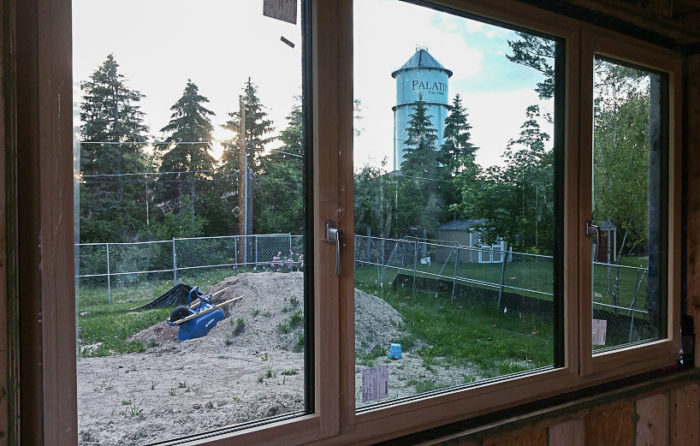
And you get a real sense of just how effective the tinting is when you stand inside and look out between a picture window and an open window.
Even in the hottest sunlight, the interior side of the glass only warms slightly. And because the tinting isn’t automatic, its effect is subtle and feels natural as it changes. It’s a really impressive product.
With most of the windows and doors installed, I could start thinking about installing my ERV and ductless minisplit system, planning for my first blower door test, and scheduling the install of our siding.
It felt like a really big step in the build — and it meant no more blue tarps covering the window openings to keep the rain out.
Although the days were long, it helped having my wife and daughter on the job site all the time. It also gave my daughter a once-in-a-lifetime chance to play on an active construction site, and she had a blast.

Six months had gone by, and we had already survived a lot, with much more to come.
Other posts by Eric Whetzel:
- Attic Insulation
- Installing an Airtight Attic Hatch
- Air Sealing the Exterior Sheathing
- Installing a Solar Electric System
- Prepping for a Basement Slab
- Building a Service Core
- Air Sealing the Attic Floor
- Ventilation Baffles
- Up on the Roof
- A Light Down Below
- Kneewalls, Subfloor and Exterior Walls
- Let the Framing Begin
- Details for an Insulated Foundation
- The Cedar Siding is Here — Let’s Burn It
- An Introduction to a New Passive House Project
Weekly Newsletter
Get building science and energy efficiency advice, plus special offers, in your inbox.




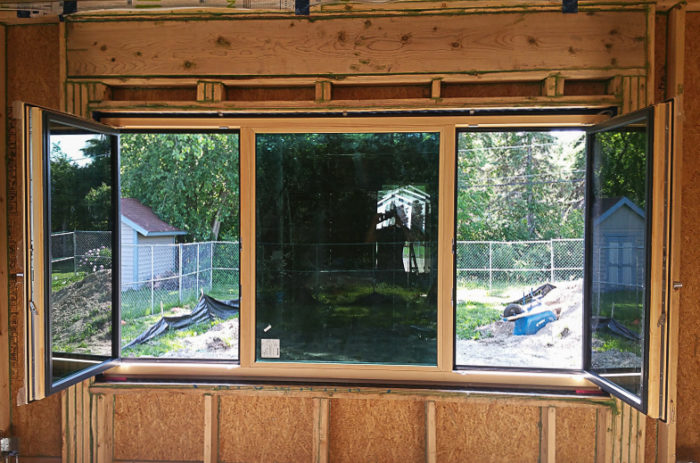

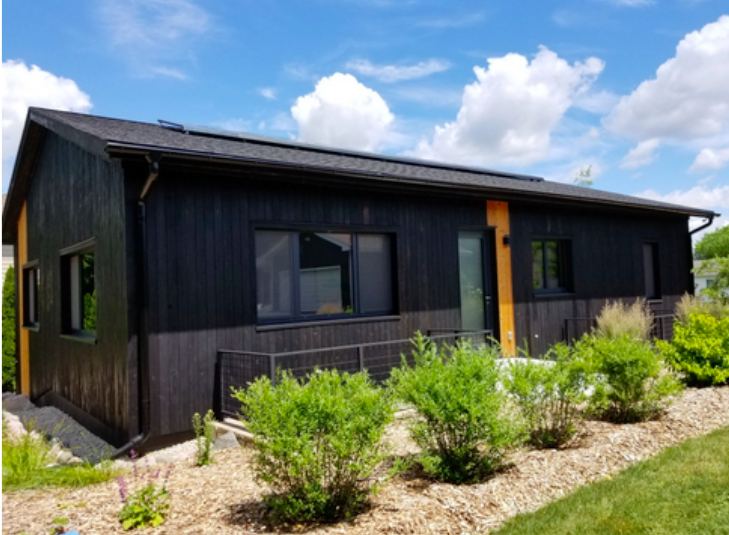
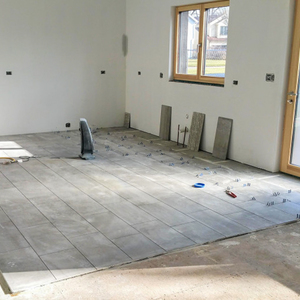
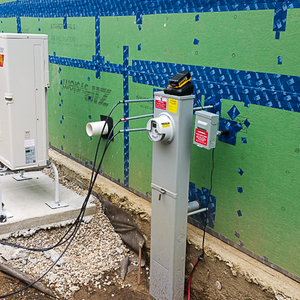






One Comment
A really good article I have to admit. I personally invested in Dako windows. I can say, that I was quite happy with the product I got. These windows, are high quality. In other words, I was provided with a really good product at a relatively low price.
Log in or create an account to post a comment.
Sign up Log in